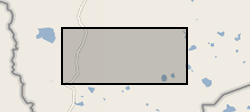txt
Type of resources
Topics
Keywords
Contact for the resource
Provided by
Years
Formats
Representation types
Update frequencies
Resolution
-
These data are the simulated peat heights and water-table depths (both in cm) from a DigiBog run. The virtual peatland was configured as a 2-D transect of 100 x 2m x 2m columns. The data were generated for each year of a 5,100-year run. After 4,900 years, six ditches were added and the model allowed to run for a further 100 years. After this time, the ditches were ‘restored’ and the simulation continued until a total runtime of 5,100 years had elapsed. Full details about this dataset can be found at https://doi.org/10.5285/1d16b303-ca1d-43b4-93b1-c8172adc9792
-
This is a theoretical model of leadership in warfare by exploitative individuals who reap the benefits of conflict while avoiding the costs. In this model we extend the classic hawk-dove model to consider pairwise interactions between groups in which a randomly chosen leader decides whether the group will collectively adopt aggressive or peaceful tactics. We allow for unequal sharing of fitness payoffs among group members such that the leader can obtain either a larger share of the benefits, or pay a reduced share of costs, from fighting compared to their followers. Our model shows that leadership of this kind can explain the evolution of severe collective violence in certain animal societies. Full details about this application can be found at https://doi.org/10.5285/7aab999e-cef9-41c2-8400-63f10af798ec
-
This dataset is a compilation of results obtained from vegetation surveys in the Stalybride estate moorlands (commonly known as the Saddleworth moors) following a wildfire in 2018. Ten plots were established in October 2018 at the post-fire site which were 10 m x 10 m in size. Five plots were identified as suffering a less severe (shallow) burn. The other 5 plots were in areas where a more severe (deep) burn. In all plots the surface vegetation had been removed by the fire exposing the bare peat. The data file contains: (1) On-site post-fire vegetation data – species ID and coverage, and (2) species presence in the one-year post-fire seed bank. The dataset is the result of research in the light of an NERC Urgency grant entitled 'RECOUP-Moor: Restoring Ecosystem CarbOn Uptake of Post-fire Moorland' (NE/S011943/1, led by Dr. Bjorn Robroek of the University of Southampton (now Radboud University Nijmegen, the Netherlands). Full details about this dataset can be found at https://doi.org/10.5285/56561ed3-55d0-454c-a6b9-7e633ccf9647
-
Phenotypes (growth and phenology) for Scots pine trees in a long-term common garden trial planted in three sites in Scotland, surveyed annually from 2013 to 2020. Full details about this dataset can be found at https://doi.org/10.5285/1c9367fb-ea87-47a1-8257-d9fed54215e7
-
This dataset contains biogeochemical and edaphic information from burned peat soil on the Stalybridge estate located near Manchester (UK), commonly referred to as Saddleworth moor. This study was conducted after a wildfire fire on the Saddleworth moor in June 2018. The sample plots included areas with deep and shallow peat burn. The data includes geographical information (location, elevation and slope), soil temperature and soil chemical composition (carbon, nitrogen and 22 other elements). The dataset is the result of research funded by a NERC Urgency grant entitled 'RECOUP-Moor: Restoring Ecosystem CarbOn Uptake of Post-fire Moorland' (NE/S011943/1, led by Dr. Bjorn Robroek of the University of Southampton (now Radboud University Nijmegen, the Netherlands). Full details about this dataset can be found at https://doi.org/10.5285/1fa8d605-b996-4687-ace2-1fa59cd5c6dd
-
Data comprise soil organic carbon content from a simulation using the ECOSSE model; a pool-based carbon and nitrogen turnover model. Simulations were performed using input data from the Sunjia research farm in southeast China (Jianxi province). Data here is from simulations using the global version of the ECOSSE model, a package which applies the regular model spatially. Input data for the simulations were provided by the soil science department of the Chinese Academy of Sciences. Simulations were conducted in 2018. Full details about this dataset can be found at https://doi.org/10.5285/876fa724-c3d3-4091-8de2-8140b7c973eb
-

Microgravity data collected at Uturuncu Volcano between March 2010 and November 2018 The file contains microgravity data collected between March 2010 and November 2018 in the Altiplano-Puna Volcanic complex.
-
Data were collected in 2015, 2016 and 2017 to provide Digital Surface Models (DSM) for two sections of the South Saskatchewan River, Canada. DSMs were generated using aerial plane images with a 0.06m ground resolution, captured at a height of c. 1500 m from a fixed-wing aeroplane with an UltraCamXp sensor. DSMs were generated as part of NERC project NE/L00738X/1. DSMs were constructed using imagery obtained on four occasions (13th May 2015; 2nd Sept 2016; 8th June 2017; and 12th June 2017). The dataset consists of eight DSMs; one for each of the two river sections on each of the four dates. Full details about this dataset can be found at https://doi.org/10.5285/13695138-227f-4d85-9049-0a9cba9e1867
-
This dataset contains half-hourly output data (for the year 2011) generated by a preliminary version of the Shrubland Ecosystem Assessment (SEcA) model. SEcA calculates the ecosystem processes for a semi-arid shrubland system, for this dataset the model has been configured for a Caatinga ecosystem. The model generates four output files, those generating the aerodynamic and surface resistances, state variables, energy balance fluxes, and carbon flux-related outputs. The data provided here relate to model runs with the JULES Farquhar model, with the Sinclair plant water stress switched on. This work was funded by Newton/NERC/FAPESP Nordeste project: NE/N012488/1. Full details about this dataset can be found at https://doi.org/10.5285/ad86c0d3-624c-4ae3-9280-8d1ccbe14929
-
Data consists of gene expression estimates and encapsulation rates in wild caught Drosophila melanogaster larvae following exposure to different treatments. Treatments include injection with wasp homogenate, injection with oil and no injection. Also provided are functional enrichment categories for differentially expressed genes and library generation and read mapping metrics. The data were produced under the grant: NE/P00184X/1 Why does Drosophila vary in susceptibility to parasitoid wasps. Full details about this dataset can be found at https://doi.org/10.5285/06ea87f3-476d-40fd-acce-e6923e786d48
 NERC Data Catalogue Service
NERC Data Catalogue Service